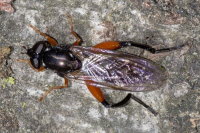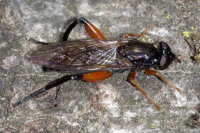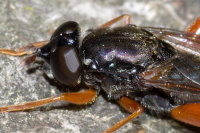Stamm Arthropoda (Gliederfüßer) ➔ Unterstamm Hexapoda (Sechsfüßer) ➔ Klasse Insecta (Insekten) ➔ Ordnung Diptera (Zweiflügler) ➔ Familie Syrphidae (Schwebfliegen)
Chalcosyrphus (Xylotomima) valgus (Gmelin, 1790)
Synonyme und andere Kombinationen:
Syrphus valgus Gmelin, 1790 | Musca valga Gmelin, 1790 (potentially valid) | Syrphus volvulus Fabricius, 1794 | Zelima sapporoensis Shiraki, 1930 |
Einordnung:
Chalcosyrphus valgus gehört zur Unterfamilie Eristalinae, Tribus Milesiini.Verbreitung:
Von Skandinavien nach Süden bis zu den Pyrenäen; von Nordfrankreich nach Osten durch Mittel- und Südeuropa in die asiatischen Teile Russlands fast bis zur Pazifikküste; China.Lebensraum:
Laub- und Nadelwälder mit überalterten Bäumen (Fagus, Picea, Pinus, Quercus, Carpinus)Beschreibung:
Körperlänge 12 - 15 mmÄhnliche Arten:
Ähnliche Arten sind Chalcosyrphus femoratus (Linnaeus, 1758) (Große Faulholzschwebfliege) und Chalcosyrphus rufipes (Loew, 1873).Lebensweise:
Chalcosyrphus valgus fliegt von Mai bis Juli. Die Imagines besuchen die Blüten von Campanula, Chaerophyllum, Hypericum, Rubus idaeus und Sorbus aucuparia.Die Larven entwickeln sich in verrottendem Holz.
Quellen, weiterführende Literatur, Links:
- Pape T. & Thompson F.C. (eds) (2017). Systema Dipterorum (version 2.0, Jan 2011). In: Species 2000 & ITIS Catalogue of Life, 2017 Annual Checklist (Roskov Y., Abucay L., Orrell T., Nicolson D., Bailly N., Kirk P.M., Bourgoin T., DeWalt R.E., Decock W., De Wever A., Nieukerken E. van, Zarucchi J., Penev L., eds.). Digital resource at www.catalogueoflife.org/annual-checklist/2017. Species 2000: Naturalis, Leiden, the Netherlands. ISSN 2405-884X.
- M.C.D.Speight: Species Accounts of European Syrphidae (Diptera), Glasgow 2017, Syrph the Net, the database of European Syrphidae, vol. 97, 294 pp., Syrph the Net publications, Dublin.
- Speight, M.C.D. & Sarthou, J.-P.: StN keys for the identification of adult European Syrphidae (Diptera), Glasgow 2011/Clés StN pour la détermination des adultes des Syrphidae Européens (Diptères), Glasgow 2011. Syrph the Net, the database of European Syrphidae, Vol. 66, 120 pp, Syrph the Net publications, Dublin.
- Gerald Bothe: Bestimmungsschlüssel für die Schwebfliegen (Diptera, Syrphidae) Deutschlands und der Niederlande, DJN, 1984, ISBN 3-923376-07-3
- Anasimyia interpuncta
- Anasimyia transfuga
- Brachyopa sp.
- Brachypalpus sp.
- Ceriana conopsoides
- Ceriana vespiformis
- Chalcosyrphus valgus
- Cheilosia sp.
- Chrysogaster sp.
- Chrysotoxum fasciatum
- Criorhina berberina
- Dasysyrphus sp.
- Didea sp.
- Epistrophe melanostoma/nitidicollis
- Epistrophella euchroma
- Eristalinus megacephalus
- Eristalinus taeniops
- Eristalis similis
- Eristalis sp.
- Eumerus purpurariae
- Eumerus sp.
- Eupeodes sp.
- Hammerschmidtia ferruginea
- Helophilus sp.
- Ischiodon aegyptius
- Melanogaster sp.
- Meligramma triangulifera
- Merodon ambiguus
- Merodon avidus
- Merodon moenium
- Merodon obscuritarsis
- Merodon sp.
- Microdon analis/major
- Microdon mutabilis/myrmicae
- Orthonevra sp.
- Paragus sp.
- Parhelophilus sp.
- Pipiza austriaca
- Pipiza bimaculata
- Pipiza fenestrata
- Pipiza sp.
- Platycheirus rosarum
- Platycheirus sp.
- Rhingia rostrata
- Scaeva albomaculata
- Sphaerophoria rueppelli
- Sphaerophoria sp.
- Sphegina sp.
- Spilomyia saltuum
- Syrphus sp.
- Temnostoma meridionale
- Blaue Breitbandschwebfliege
- Braune Mulmschwebfliege
- Breitband-Waldschwebfliege
- Bunte Erzschwebfliege
- Dolden-Frühlingsschwebfliege
- Dunkle Blattlausschwebfliege
- Frühe Bienenschwebfliege
- Frühe Frühlingsschwebfliege
- Frühe Gelbrandschwebfliege
- Frühe Großstirnschwebfliege
- Garten-Keilfleckschwebfliege
- Gebänderte Waldschwebfliege
- Gelbbein-Wiesenschwebfliege
- Gelbe Breitbauchschwebfliege
- Gelbe Weißdornschwebfliege
- Gelbhaarige Wiesenschwebfliege
- Gemeine Erzschwebfliege
- Gemeine Feldschwebfliege
- Gemeine Keilfleckschwebfliege
- Gemeine Keulenschwebfliege
- Gemeine Langbauchschwebfliege
- Gemeine Langbauchschwebfliege
- Gemeine Narzissenschwebfliege
- Gemeine Schattenschwebfliege
- Gemeine Schnauzenschwebfliege
- Gemeine Sumpfschwebfliege
- Gemeine Waldschwebfliege
- Gemeine Winterschwebfliege
- Gestreifte Nasenschwebfliege
- Gestreifte Waldschwebfliege
- Glänzende Faulschlammschwebfliege
- Glänzende Keilfleckschwebfliege
- Goldhaar-Langbauchschwebfliege
- Goldschwebfliege
- Große Faulholzschwebfliege
- Große Schwebfliege
- Große Sumpfschwebfliege
- Große Torfschwebfliege
- Große Wiesenschwebfliege
- Helle Sumpfschwebfliege
- Hornissenschwebfliege
- Hummel-Keilfleckschwebfliege
- Hummel-Moderholzschwebfliege
- Hummel-Waldschwebfliege
- Hundeschnauzenschwebfliege
- Keulen-Grashalmschwebfliege
- Kleine Erzschwebfliege
- Kleine Keilfleckschwebfliege
- Kleine Schwebfliege
- Kurze Langbauchschwebfliege
- Langbauchschwebfliege
- Matte Schwarzkopfschwebfliege
- Mistbiene
- Mittlere Keilfleckschwebfliege
- Mondfleck-Feldschwebfliege
- Pelzige Erzschwebfliege
- Pilz-Erzschwebfliege
- Rote Holzmulmschwebfliege
- Schmale Breitbauchschwebfliege
- Schwarzfuß-Wiesenschwebfliege
- Späte Frühlingsschwebfliege
- Späte Gelbrandschwebfliege
- Späte Großstirnschwebfliege
- Späte Wespenschwebfliege
- Totenkopfschwebfliege
- Verrall´s Wespenschwebfliege
- Vierfleck-Frühlingsschwebfliege
- Vierfleck-Waldrandschwebfliege
- Weiden-Erzschwebfliege
- Weißband-Torfschwebfliege
- Weißbandschwebfliege
- Weiße Breitbandschwebfliege
- Weißfuß-Erzschwebfliege
- Wespen-Moderholzschwebfliege
- Zweiband-Wespenschwebfliege
- Zweiband-Wiesenschwebfliege



